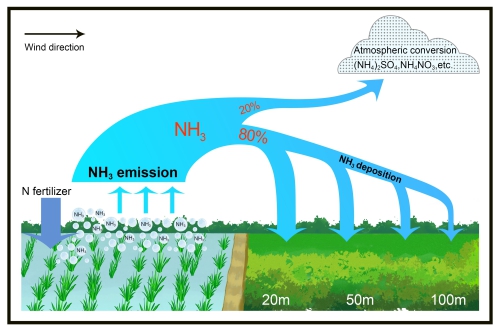Livestock production and nitrogen fertilizer used in croplands emit lots of ammonia, which is the most abundant alkaline gas in ambient air. In recent years, Chinese scientists have suggested reducing ammonia emissions as an effective measure to alleviate aerosol pollution because ammonia can react with acidic gases to form aerosols and pollution.
“Ammonia is also reactive and sticky, and can be removed from the atmosphere quickly. We call this process dry deposition,” explains Dr SHEN Jianlin, from the Institute of Subtropical Agriculture, Chinese Academy of Sciences. “Agricultural sources contribute to most of the ammonia emissions, but whether all the ammonia emitted from agriculture enters the atmosphere needs to be urgently evaluated.” This was the motivation behind a study conducted by Dr Shen and colleagues, recently published study in Atmospheric and Oceanic Science Letters, which is hosted by Institute of Atmospheric Physics, Chinese Academy of Sciences.
The ammonia emissions intensity is relatively high in the subtropical hilly regions of China. The pattern of distribution of croplands or animal farms accompanying the surrounding natural ecosystems in this region may result in a large proportion of the emitted ammonia being deposited in the neighborhood of the sources before entering the atmosphere. Thus, it is important to determine the fate of the emitted ammonia in these subtropical hilly regions of China.
"Paddy fields constitute a major type of cropland in the subtropical hilly regions of China. We developed a method to measure the ammonia dry deposition around ammonia emission sources, and used it to measure the ammonia concentrations and dry deposition within 100 m around paddy fields (0.6 ha) with double rice cropping in the subtropical hilly area of southern China," says Dr Shen.

Ammonia emissions, deposition, and conversion to aerosols in the atmosphere. (Image by Jianlin Shen)
Based on this study, it was found that there were high ammonia concentrations at downwind sites within 100 m from the paddy fields, which occurred during the 15 days after nitrogen fertilizer application. With an increase in distance from the paddy fields, the atmospheric ammonia concentration at the downwind sites decreased exponentially. Ammonia deposition within 100 m downwind of the paddy fields accounted for about 80% of the ammonia emitted from the paddy fields, and thus only about 20% of the emitted ammonia entered into the atmosphere to form aerosols.
"Our study indicates that ammonia deposition in the neighborhood of sources can largely reduce the amount of emitted ammonia entering the atmosphere, and thus can reduce atmospheric ammonia pollution. This mechanism should be considered in inventory compilations in order to objectively assess the potential impact of agricultural ammonia emissions on air pollution. Measures to increase the level of ammonia deposition around sources, such as by planting trees, are advocated to reduce the amount of ammonia pollution," concludes Dr Shen.
"This study is only a case study. In the future, we intend to study the dry deposition of ammonia around sources with different emission intensities to assess the fate of ammonia when it is emitted from these sources,” adds Shen.
Citation:
Yuchen YI, Jianlin SHEN, Chaodong YANG, Juan WANG, Yong LI & Jinshui WU (2020): Dry deposition of ammonia around paddy fields in the subtropical hilly area in southern China, Atmospheric and Oceanic Science Letters, 13(3). DOI: 10.1080/16742834.2020.1738208. https://doi.org/10.1080/16742834.2020.1738208
Media Contact: Ms. LIN Zheng, jennylin@mail.iap.ac.cn
